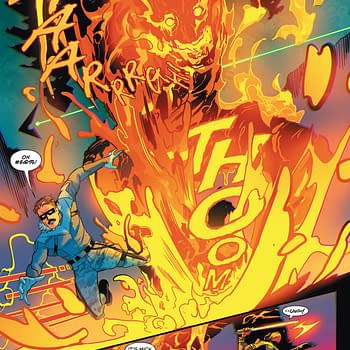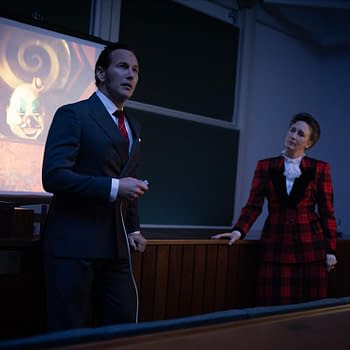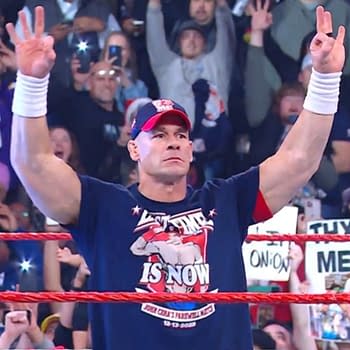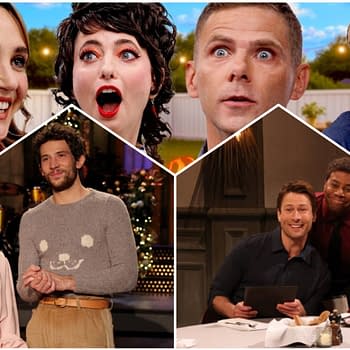Posted in: Comics, Movies, Review, TV | Tagged: buffy the vampire slayer, Francesca Lia Block, harry potter, Jody Lynn Nye, neo edmund, Rebecca Moesta, Stan Lee's Comikaze, WordFire Press
Stan Lee's Comikaze 2015: Panel Experts Discuss Creating Awesome Fairy Tale Characters
By Michele Brittany, SoCal Correspondent
A Tale of Red Riding: Rise of the Alpha Huntress author Neo Edmund began the Friday afternoon panel Fairy Tales, Then and New! Creating Awesome Characters and Fantasy Worlds by introducing a panel of eminent fairy tale writers in the industry. The panelists included Rebecca Moesta is the co-owner of WordFire Press and writer of several Star Wars stories; Jody Lynn Nye has written a dozen MythAdventures novels and collaborated with Anne McCaffrey and Robert Lynn Asprin; and Francesca Lia Block is the author of over 30 novels including The Rose and the Beast and Beyond the Pale Motel.
As consumers of stories, we are exposed to a multitude of female characters. In classic literature and fairy tales of old, girls and women were typically cast as a nurturer, a femme fatale, a friend or the ingenue, often serving as the damsel in distress. While those stereotypes have remained in our narratives, within modern stories could be found an additional female trope: the woman who knew just about everything and do just about anything. They were perfect yet unrealistic role models.
Edmund stated the perfect woman trope, along with the other familiar ones, left a demand for role models that would resonate with female audiences. Block explained that more recently, writers have been revisiting those fairy tale tropes, twisting them so the female character would be more interesting. She added that she felt much of the recent trends can be attributed to the rise of the indie publishing scene.
Nye believed the demand started even earlier, with opening years of 1970s; it was "the point when women started becoming visible as creator of stories that featured women heroines" and when women began writing science fiction and fantasy under their own names, such as Anne McCaffery. In fact, Nye had attended GenCon around that time and relayed that she was one of six women that attended. Edmund shared that as recently as fifteen years ago, he remembered that girls and women at events and in the local comic book shops was still rare. "Women cannot be marginalized in the industry any longer," Edmund added.
Successful modern characters are humanized and no longer perfect. "A sympathetic character has to have a special gift and an extreme negative that becomes their flaw, which ultimately humanizes them," Block explained. "They also have to have a real want" and a story that will result in a change for that character.
"I like to play with traits and weave archetypes together," Moesta said. However, she cautioned that when developing characters, writers must make sure that their characters have legitimate reasons for acting "out of character". For example, Edmund said he will watch or read a story with a female character who will do something fantastic and then apologize afterwards.
Moesta said she was a fan girl of Buffy the Vampire Slayer, however there were aspects of Buffy's character that she felt were missing from the story. She got the chance to add her spin on Buffy when she was offered the opportunity to write a novel in Buffyverse, which resulted in Little Things (2002). In her novel, she created vampire fairies and Buffy had to deal with a toothache – her vulnerable Achilles heel. It may seem minor, but it impacted how she interacted with her friends and dealt with her foes.
Nye described that she uses stereotypical characters, twisting and drawing out their strengths in order to create a "real" human being for her characters. She brought up the Bechdel test – in a scene where there are two or more women engaged in conversation, do they talk about something other then a man? – as a way of determining if the women are active in the story or perpetuating gender inequality. A few members of the audience asked clarifying questions about the test and Edmund interjected that writers should write the characters to fit the story, because yes, there are situations where two characters will talk about the opposite sex and will not be engendering inequality.
Edmund asked how each panelist approaches and creates strong leading characters. "You have to write a complex character," Moesta said. "There isn't anything surprising with writing female characters. It's the same process and the same character structure." She reminisced when she had to project herself into the boys of the stories she was reading: boys got to do all of the fun things.
Block advised she looked internally for creating her characters. "Look at what demons you are dealing with and personalize a fairy tale to your own experience." Nye explained she creates and structures her female and LGBT characters exactly as she does any other character. She shared a story in which she was criticized for making a LGBT character a villain, but Nye explained that every character has a turn as the villain.
Did each panelist have a process to create their characters? Moesta stated she starts with a character sheet with all of the basics: physical description, how they speak, strengths and weaknesses, and any phobias they may have. She added that as she is writing her story, the characters will grow into their own and their characteristics may shift a little. Likenesses of established characters in films and television do on occasion inspire Moesta with her own characters.
Nye agreed that she uses character sheets too so she can keep track of everyone. She cautioned about DFS – Dead Family Syndrome – and that writers still have to create a family history for those characters with no or a limited number of family members. They do impact the living characters. Coming from a gamer perspective, Edmund stated he uses character sheets too. He added that he will write a one-page character study, in that character's voice. He conveyed that it allows him to hear their voice.
Block explained the significance of Carl Jung's theory on dreams, saying, "everything in your dream is part of you." Applying that to the process of creating characters, she believes that the characters are also a part of the writer. Block said that she teaches her students to develop characters by taking a personal character trait and fleshing it out with a name and their physical description to start. "It's the best moment when the character starts talking themselves."
It sounded easy to create intriguing female characters and really no different from creating male characters and while strides have been made for creating fictional female role models, Nye provided disappointing news. It seems harder to have female characters in our narratives today, and requires writing protest letters to get them included in projects, such as film and television. Nye looked to Hermione Granger from the Harry Potter books by J.K Rowling as an example where a strong literary female character is "dumbed down" in the filmic version. In the books, Hermione had solved cases, but in the films, her importance was minimized and her actions were shifted away from her character. Block added that having female names associated with projects still get rejected.
With the hour almost at an end, Edmund provided the audience the opportunity to ask questions. One person, a member of the Producers Guild of America, shared with the group that there is a tool kit [The MS Factor Toolkit: The Power of Female Driven Content] that is free and available to everyone online. It contains industry statistics that writers would find helpful.
A male attendee asked for advice on writing convincing female characters. Nye suggested reaching out to female relatives and friends for feedback on his character development. Moesta mentioned that when writing movie scenes can reveal a character's motivation and provides cues to the writer and the viewer. She reminded the audience that men and women have different motivations and process events and interactions differently from each other.
The last question was intriguing and difficult to be answered in the minute left: can and are male viewers identifying with narratives where lead protagonist is a female? Each panelist chimed with brief answers. Nye took the angle that projects, such as the "chick flick" and "mens action adventure," will be marketed differently from each other and will appeal more strongly to the segment of viewers they are targeting. Moesta came from a physiological perspective between genders – pointing out actions are nurtured or natural. Edmund said he tries to write "gender neutral" so the characters will appeal to either sex. And Block advised writing great stories with solid characters, which would have wider appeal to audiences.
Panel photos taken by Michele Brittany.
Michele Brittany is an independent popular culture scholar and semi-professional photographer. She has edited James Bond and Popular Culture: Essays on the Influence of the Fictional Superspy (McFarland & Company) as well as the forthcoming book Essays on Space Horror in Film, 1950s – 2000s. Follow Michele on Twitter: @mcbrittany2014.


























